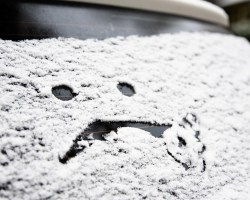Leaves are falling, pumpkin-spice lattes are brewing, and Blundstones and plaid circle scarfs abound — winter is coming, and along with it, so is seasonal affective disorder. SAD is a type of depression that severely affects roughly 3 per cent of Canadians and mildly impacts another 15 per cent.

A posed snow sculpture on the morning of Oct.1, 2018.
Studies have shown that SAD is most likely triggered by a lack of sunlight, which plagues the Prairies during the winter months. With shorter days, dormant flora and frigidly freezing temperatures present alongside the always augmenting workload of the mid-semester smackdown, University of Saskatchewan students are left vulnerable to seasonal affective disorder.
How does one plan to tackle the impending lethargy, fatigue, sadness and irritability — amongst other common symptoms — caused by the blizzard blues? Well, here are a five simple yet potentially helpful tips.
Take your vitamins!
If you’re feeling the seasonal sadness, and you don’t happen to be one of the very few students who bike to school during the winter months, chances are you’re not getting outside enough.
You have to substitute that lost sunshine somehow. Check out your local pharmacy, and pick up some vitamin D supplements to help your body process your winter woes. Additionally, vitamin B6 helps regulate several of the neurotransmitters that manage mood, stress and sleep. Omega-3 supplements can help with brain function and mood as well.
It’s the rhythm, baby: Circadian rhythm
Less sunlight and more darkness means it’s a heck of a lot harder to get out of bed. SAD, in combination with the seemingly eternal darkness of winter, can leave many people feeling fatigued. I have been using this free alarm clock app called Sleep Cycle, which basically monitors sleep patterns and wakes you up in the lightest of sleep phases — leaving you feeling energized.
Honestly, I have no idea if this app legitimately works, but either way, as someone who regularly misses 10:00 a.m. classes, the quality of my sleep and energy levels have drastically improved since I started using Sleep Cycle. Placebo or not, the extra boost is definitely worth it.
Faux sunlight is so in right now
SAD is driven by a lack of exposure to sunlight, and thankfully, there are some fabricated options other than the actual sun. A variety of products can be found on the market ranging from dawn-replicating alarm clocks to full-on sun lamps.
While I fully recognize that this particular suggestion is not accessible to the majority of the student population — including myself — due to its high cost, light therapy has been proven to be a highly successful treatment for SAD. So, if you can, give it a go.
Counselling is cool
Honestly, counselling is always a good idea. Talking to a counsellor can’t guarantee the vanishment of SAD symptoms, but it can help you learn to recognize harmful patterns and develop tools to combat them. If you think that visiting a counsellor could be helpful to you, contact the Student Wellness Centre, as the U of S offers counselling services on campus that are covered by your student fees.
Medications
Let’s face it — the first three suggestions are quite miniscule in effect. SAD, like any other mental illness, impacts the chemicals and neurotransmitters of the brain. If vitamin D and sleep apps just aren’t enough, talk to your doctor about the possibility of prescription medications. If you don’t have a doctor or are new to Saskatoon, contact the Student Wellness Centre for an appointment.
SAD can trigger severe bouts of depression and is a serious mental-health issue. As someone who experiences SAD year after year, I know full well that these quick tips are not catch-all solutions that instantly cure seasonal affective disorder. However, if any of these suggestions make a fraction of a difference this upcoming winter season, I think they are worth a fair shot.
—
Ashlynn Weisberg
Photo: Riley Deacon / Photo Editor